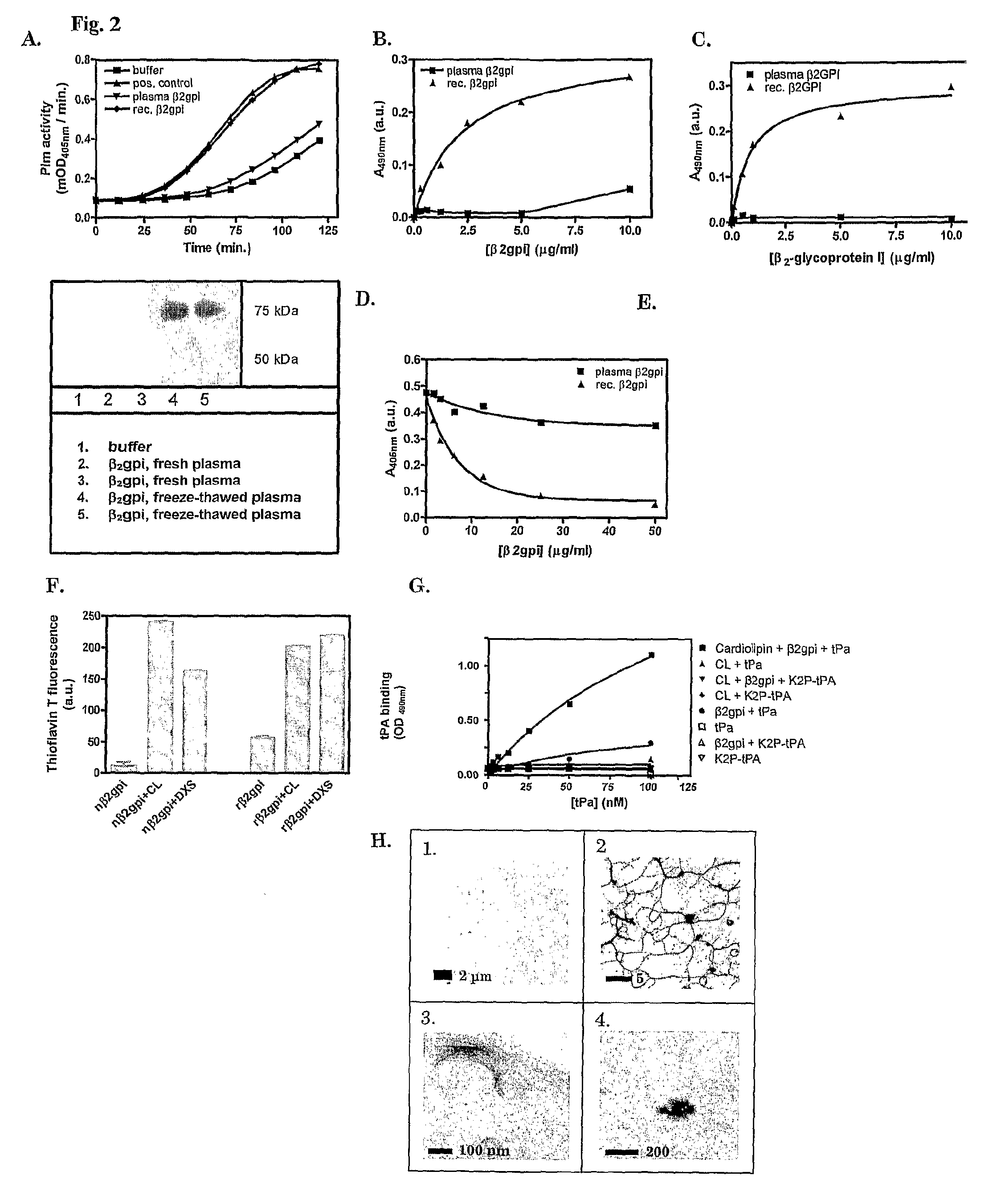Cross-β structure binding compounds
a cross- structure and compound technology, applied in the field of biological and biophysical chemistry, can solve the problems of delayed plastic clotting, toxic structure of polypeptide tubes, and inability to anticipate the common structural basis underlying the acquired tpa binding, and achieve the effect of relieving patients of negative effects
- Summary
- Abstract
- Description
- Claims
- Application Information
AI Technical Summary
Benefits of technology
Problems solved by technology
Method used
Image
Examples
example 1
Monoclonal Antibodies Bind Specifically to Peptide and Protein Aggregates with Amyloid-Like Cross-β Structure Conformation
Methods: Preparation of Hybridomas that Produce Anti-Cross-β Structure Antibodies
[0114]Before immunization of a mouse, preparations of amyloid-β peptide 1-40 Dutch type, with mutation E22Q (Aβ), fibrin peptide KRLEVDIDIGIRS (FP13 K157G) (SEQ ID NO:2), fibrin peptide IDIKIR (FP6) (SEQ ID NO:4) (all from the Peptide Synthesis Facility, Netherlands Cancer Institute NKI, Amsterdam, The Netherlands), glycated hemoglobin (Hb-AGE) and γ-globulins (G4386, Sigma, Zwijndrecht, The Netherlands) were tested for the presence of cross-β structure conformation. Lyophilized Aβ, FP13 K157G, FP6 and human γ-globulins were dissolved at 10 mg ml−1 in 1,1,1,6,6,6-hexafluoro-2-propanol and trifluoroacetic acid in a 1:1 volume ratio. Solvent was evaporated under an air stream and the polypeptides were dissolved in H2O. Aβ and FP6 at 10 mg ml−1, FP13 K157G at 2 mg ml−1 and γ-globulins a...
example 2
Anti-β2GPI Autoantibodies Derived from Patients with Antiphospholipid Syndrome Recognize β2GPI Comprising Cross-β Structure, but not Native β2GPI
Materials & Methods
Plasminogen Activation Assay.
[0128]Plasmin (Plm) activity was assayed as described.4 Peptides and proteins that were tested for their stimulatory ability were used at 100 μg ml−1, unless stated otherwise. Tissue-type plasminogen activator (tPA, Actilyse, Boehringer-Ingelheim) and plasminogen (Plg, purified form human plasma by lysine-affinity chromatography) were used at concentrations of 400 pM and 1.1 or 0.22 μM, respectively. Chromogenic substrate S-2251 (Chromogenix, Instrumentation Laboratory SpA, Milano, Italy) was used to measure PIs activity.
[0129]Fluorescence of ThT—amyloid-like protein / peptide adducts was measured as follows. Solutions of 25 μg ml−1 of protein or peptide preparations were prepared in 50 mM glycine buffer pH 9.0 with 25 μM ThT. Fluorescence was measured at 485 nm upon exc...
example 3
Two Distinct Amyloid-Like Conformations of a Peptide
Materials & Methods: Fibrin Peptide FP6 Adopts Two Distinct Amyloid-Like Conformations
[0142]Solutions of fibrin peptide FP6, NH2-IDIKIR-COOH (SEQ ID NO:4) (Peptide facility, Dutch Cancer Institute, Amsterdam, The Netherlands) were prepared in various ways. FP6 was dissolved in hexafluoro-2-propanol and trifluoroacetic acid in a 1:1 volume ratio, at approximately 10 mg ml−1. Solvents were subsequently evaporated and FP6 was dissolved in H2O at 1 mg ml−1 or at 10 mg ml−1. Batches were incubated at 37° C. or at 65° C., for 72 hours, and subsequently stored at room temperature. Before preparation of X-ray diffraction samples with the 37° C.-incubated sample at 1 mg ml−1, the solution was concentrated by air-drying to approximately 5 mg ml−1. Another amount of FP6 was dissolved directly in H2O, at 10 mg ml−1, and used immediately for preparing X-ray diffraction samples. Separate samples were prepared similarly and analyzed by electron s...
PUM
| Property | Measurement | Unit |
|---|---|---|
| molecular mass | aaaaa | aaaaa |
| concentration | aaaaa | aaaaa |
| temperature | aaaaa | aaaaa |
Abstract
Description
Claims
Application Information
 Login to View More
Login to View More - R&D
- Intellectual Property
- Life Sciences
- Materials
- Tech Scout
- Unparalleled Data Quality
- Higher Quality Content
- 60% Fewer Hallucinations
Browse by: Latest US Patents, China's latest patents, Technical Efficacy Thesaurus, Application Domain, Technology Topic, Popular Technical Reports.
© 2025 PatSnap. All rights reserved.Legal|Privacy policy|Modern Slavery Act Transparency Statement|Sitemap|About US| Contact US: help@patsnap.com



